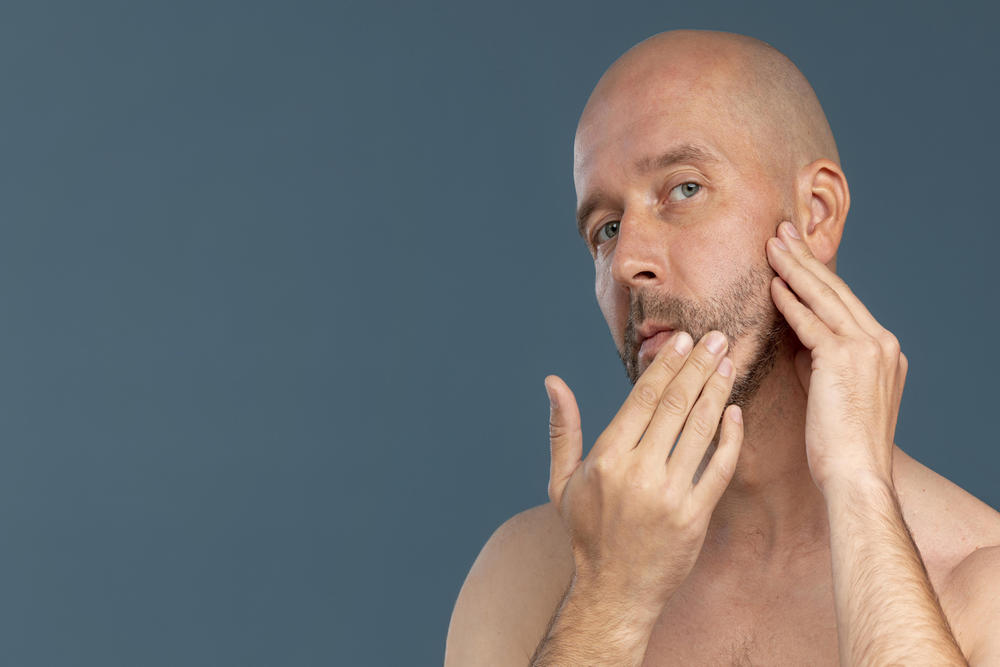Do you dream of having a thick, long, and shiny beard? You’re not alone! Many men come to my clinic wanting the same thing.
As a specialist, I know that the beard has become a symbol of masculinity. But what happens when that dream beard doesn’t come in because it grows irregularly? I understand how frustrating that can be… but I also know there are solutions.
Keep reading because today I’ll tell you everything you need to know about an irregular beard: the most common causes, treatments, and tips to help you get the thick beard you’ve always wanted.
Tabla de Contenidos
Why is my beard patchy? 🤔
Okay. I hear this question constantly in my consultations, but I want to clarify one point: what do we, as specialists, consider to be an irregular beard? An irregular beard is one that grows unevenly, meaning some areas of your face have more hair, while others have patches of skin with no hair.
There are many reasons why your beard may grow irregularly:
Age 🧑🦳
Yes, if you’re under 25, your beard has probably not yet reached its maximum growth potential. This means your facial hair may be sparse. And if you’re even younger (between 15 and 20 years old), it’s likely that the hormonal changes you’re experiencing during this stage of life affect the rate at which your beard grows.
Also, if you’re over 50, you may start noticing gaps in your beard that weren’t there before. This can be due to thinning facial hair and a slower growth cycle.
Genetic factors 🧬
I’m sorry to say this, but genetics are the main reason why your beard is irregular. If your father or grandfather had an irregular beard, or if they were clean-shaven, it’s very likely you might have the same experience.
However, there are cases where clean-shaven fathers have bearded sons (maybe because of the maternal genetics), but another factor that can influence changes in the beard is androgenetic alopecia. The density and distribution of hair follicles can change if you suffer from what’s also known as male pattern baldness.
Hormonal factors♀️ / ♂️ / ⚥
In general, testosterone is associated with the most masculine features, such as the beard. However, an excess of this hormone (specifically dihydrotestosterone, or DHT) is linked to androgenetic alopecia, which mainly affects the forehead, crown, and temples.
Here’s an important point: the beard follicles react differently to DHT than those on your head, which is why it’s common to see people without hair but with thick beards. In other cases, the beard also loses density, and patches start to appear where there used to be abundant hair.
Alopecia areata and diseases 🧑🦲
Alopecia areata is an autoimmune disease in which the immune system mistakenly attacks hair follicles. It most commonly affects the scalp, but it can also damage your beard, causing round, smooth patches.
In addition to this type of alopecia, other dermatological diseases can cause patches in your beard, such as psoriasis, seborrheic dermatitis, lupus, or ringworm.
Poor habits 🥦
Yes, your habits also affect the appearance of your beard. Pay special attention to the following:
| Nutrition | A diet lacking vitamins and minerals like iron or zinc can affect your beard growth. Fortunately, taking supplements can provide you with the nutrients you need. |
| Chronic Stress | Have you noticed that your hair falls out when you’re stressed? The same can happen to your beard, and the hair loss can either be temporary or result in slower growth. Managing your stress is key to maintaining your beard and overall health. |
| Trichotillomania | Considered a behavioral disorder and a form of obsessive-compulsive disorder, it’s characterized by repeatedly pulling out hair from the scalp or beard. Whether due to boredom, stress, or anger, it’s best to seek help from a mental health professional. |
| Improper Care | Poor shaving technique, brushing too much or too harshly, rubbing it too aggressively when drying, or not using oils and specific products for beard care can make your beard look brittle, fragile, dry, and prone to breakage. |
What can I do?
If you’re worried about why your beard is patchy and you want to take action, the first step should always be to contact a professional. At Hairfix, Hair Restoration Clinic, in addition to myself, there are other trichology specialists who are happy to examine your case, find the causes, and offer treatments to improve the quality and quantity of your beard.
The treatment for an irregular beard is not one-size-fits-all. Usually, several things are needed to get a beautiful and full beard:
- Cleansing: Use special products to wash and hydrate your beard. Don’t wash it with hand soap or shampoo. I also recommend using oils to keep your beard soft and nourish the follicles.
- Brushing: Yes, your beard should be brushed to distribute natural oils and stimulate blood circulation, which carries nutrients that promote growth. Choose high-quality brushes specifically made for your beard.
- Shaving: I know you can shave at home, but seeing a professional can be key to getting a strategic trim that hides the less dense areas and enhances your features.
- Balanced Diet: Make sure you consume enough vitamins, minerals, healthy fats, and lean proteins to get all the nutrients your beard needs. Supplements such as B-complex vitamins, biotin, and zinc are recommended to strengthen the hair.
Specialized Treatments
🧴 Minoxidil: A drug that stimulates hair growth and can be used on the beard, but always under medical prescription and supervision.
💉 Mesotherapy: A minimally invasive technique where nutrients are injected to improve hair health, stop hair loss, and stimulate growth.
👨⚕️ Beard Transplant: This is the definitive solution to increase density and achieve a more defined beard line.
Ready to Get the Beard of Your Dreams?
If changes to your lifestyle and personal care haven’t been enough, and you dream of a fuller, denser beard, now is the time to seek a permanent solution. At Hairfix, we are a Hair Restoration Clinic where we offer mesotherapy and beard transplants to help you achieve your goals.
Schedule your appointment with me or one of the other specialists at Hairfix. Your ideal beard could be closer than you think!





